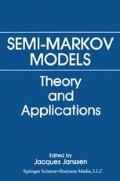Abstract
In this paper we consider the use of semi-Markov models for manpower planning. In general, the system consists of a number of transient states, or grades, and the state of having left, which is usually absorbing. The individual progresses from one state to another as he is promoted through the company hierarchy. For example, in a university the states could be lecturer, senior lecturer, professor, and left as described by Young and Almond (1961). Alternatively the states may correspond to degrees of committment to the firm (e.g., Herbst, 1963).
Access this chapter
Tax calculation will be finalised at checkout
Purchases are for personal use only
Preview
Unable to display preview. Download preview PDF.
References
D.J. Bartholomew (1959), “Note on the measurement and prediction of labour turnover”, J.R. Statist. Soc. A 122, 232–239.
D.J. Bartholomew (1977), “The analysis of data arising from stochastic processes”, 145-174, in “The analysis of survey data, Vol. 2, model fitting” ed. C.A. O’Murcheartaigh and P. Payne, Wiley.
D.J. Bartholomew and A.F. Forbes (1979), “Statistical techniques for manpower planning”, Wiley.
R.B. Ginsberg (1971), “Semi-Markov processes and mobility”, J. Math. Sociology, 1, 233–262.
P.G. Herbst (1963), “Organizational committment: a decision model” Acta Sociologica 7, 34–35.
M. Hedberg (1961), “The turnover of labour in industry, an actuarial study”, Acta Sociologica 5, 129–143.
J.D. Kalbfleisch and R.L. Prentice, “The statistical analysis of failure time data”, New York, Wiley.
E.L. Kaplan and P. Meier (1958), “Non-parametric estimation from incomplete observations”, J. Am. Stat. Assoc, 53, 457–481.
S. Lagakos, S.J. Sommer and M. Zelen (1978), “Semi-Markov models for partially censored data”, Biometrika 65, 311–317.
K.F. Lane and J.E. Andrew (1955), “A method of labour turnover analysis”, J.R. Statist. Soc. A118, 296–323.
G. Latouche (1982), “A phase type, semi-Markov point process”, Siam J. Alg. Disc. Math. 3, 77–90.
S.I. McClean (1976), “The two stage model of personnel behaviour”, J.R. Statis. Soc. A139, 205–217.
S.I. McClean (1978), “Continuous-time stochastic models for a multigrade population”, J. Appl. Prob. 15, 26–32.
S.I. McClean (1980), “A semi-Markov model for a multigrade population with Poisson recruitment”, J. Appl. Prob. 17, 846–852.
S.I. McClean (1982), “Some results for a semi-Markov model of mobility” submitted to J. of Math. Soc.
S.I. McClean (1983), “Estimation for failure time distribution using grouped follow-up data” submitted to Applied Statistics.
S.I. McClean and J.O. Gribbin (1982), “Statistical estimation for failure time data which is right censored and left truncated” presented to the R.S.S. conference in York, March, 1982.
R. McGinnis (1968), “A stochastic model of social mobility” Amer.Soc. Rev. 33, 712–721.
A. Mehlmann (1980), “Semi-Markovian models in continuous time”, J. Appl. Prob. 16, 416–422.
M.F. Neuts (1979), “A versatile Markovian point process”, J. Appl. Prob. 16, 764–779.
M.F. Neuts (1982), “Matrix — geometric solutions in stochastic models” John Hopkins.
R. Pyke (1961a), “Markov renewal processes: definitions and preliminary properties”, Ann. Math. Stat. 32, 1231–42.
R. Pyke (1961b), “Markov renewal processes with finitely many states” Ann. Math. Stat. 32, 1243–59.
M.E. Thompson (1981), “Estimation of parameters of a semi-Markov process from censored records”, A.A. Prob. 13, 804–825.
A. Young (1971), “Demographic and ecological modelling for manpower planning”, in D.J. Bartholomew and B.R. Morris (1971) “Aspects of manpower planning”, English Universities Press.
A. Young and G. Almond (1961), “Predicting distributions of staff”, Computer J., 3, 246–250.
Author information
Authors and Affiliations
Editor information
Editors and Affiliations
Rights and permissions
Copyright information
© 1986 Springer Science+Business Media New York
About this chapter
Cite this chapter
McClean, S. (1986). Semi-Markov models for manpower planning. In: Janssen, J. (eds) Semi-Markov Models. Springer, Boston, MA. https://doi.org/10.1007/978-1-4899-0574-1_15
Download citation
DOI: https://doi.org/10.1007/978-1-4899-0574-1_15
Publisher Name: Springer, Boston, MA
Print ISBN: 978-1-4899-0576-5
Online ISBN: 978-1-4899-0574-1
eBook Packages: Springer Book Archive

